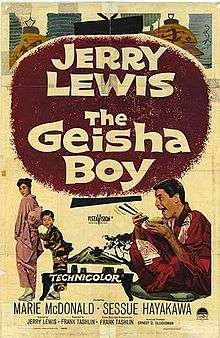The Geisha Boy
| The Geisha Boy | |
|---|---|
 | |
| Directed by | Frank Tashlin |
| Produced by | Jerry Lewis |
| Written by |
Frank Tashlin Rudy Makoul |
| Starring |
Jerry Lewis Marie McDonald Suzanne Pleshette |
| Music by | Walter Scharf |
| Cinematography | Loyal Griggs |
| Edited by | Alma Macrorie |
| Distributed by | Paramount Pictures |
Release dates | December 19, 1958 |
Running time | 99 minutes |
| Language | English |
| Box office |
$3.2 million (est. US/ Canada rentals)[1] 1,329,398 admissions (France)[2] |
The Geisha Boy is a 1958 American comedy film starring Jerry Lewis, distributed by Paramount Pictures. Filmed from June 16 to August 7, 1958, it had its first screening in New York City on December 19, 1958.[3] This film marked the film debut of Suzanne Pleshette.
Plot
The Great Wooley (Jerry Lewis) is a magician who is entertaining GIs in Japan. Upon their arrival, he causes a series of unfortunate mishaps for the headliner, actress Lola Livingston (Marie McDonald), including tearing her dress, knocking her down a flight of stairs, and rolling her up in the red carpet. An orphan, Mitsuo Watanabe (Robert Hirano) witnesses the spectacle and laughs for the first time since his parents died. When his aunt Kimi Sikita (Nobu McCarthy) brings the boy to Wooley to thank him, he and the boy become close, which irritates the aunt's boyfriend, a Japanese baseball player, as well as a USO liaison (Suzanne Pleshette) who has fallen for Wooley.
Wooley doesn't want to disappoint the boy by letting him find out that he has been a total flop, so he tries to sneak away when it is time for him to return to America. The boy follows him, and Wooley must pretend that he no longer cares for the boy, which makes him cry. However, he still follows him to America by stowing away on the plane. Once in America, they are reunited and Wooley is accused of kidnapping "Mitzi" who is then returned to Japan. Wooley follows in the same way that "Mitzi" did but is "smarter" by hiding in a specially marked trunk but must be rescued after it falls off the baggage train after which Mr. Wooley decides to stay and become a successful performer of magic in Japan along with his pet, friend and co-star, Harry the rabbit (later named Harriet, after she gave birth to a litter of baby rabbits during a performance).
Paramount Pictures
At one point in the film, the boy and Wooley look at Mount Fuji in the distance. When the arc of stars as seen in the logo for Paramount Pictures (producers of the film) flashes momentarily, Wooley does a shocked double-take.
Cast
- Jerry Lewis as Gilbert Wooley
- Marie McDonald as Lola Livingston
- Sessue Hayakawa as Mr. Sikita
- Barton MacLane as Major Ridgley
- Suzanne Pleshette as Sergeant Pearson
- Nobu McCarthy as Kimi Sikita
- Robert Hirano as Mitsuo Watanabe
- Ryuzo Demura as Ichiyama
- The Los Angeles Dodgers as Themselves
References to other films
Sessue Hayakawa, playing the orphan's grandfather, reenacts a scene that he performed in the film The Bridge on the River Kwai (1957). His workers are building a small bridge that greatly resembles the one in that film and whistling the familiar Colonel Bogey March. When Lewis stares in wonder at Hayakawa and the bridge he is building in his backyard, Hayakawa acknowledges that others have mistaken him for "the actor" and then says, "I was building bridges long before he was." This is followed by a brief clip of Alec Guinness from the film.
The Los Angeles Dodgers
The key players of the 1958 Los Angeles Dodgers (the team's first season in Los Angeles) are seen in an exhibition game against a Japanese professional team. Lewis names the players as he watches the games and is upset when the Japanese fans won't cheer his favorite team.
Home media
The film was released on DVD and Blu-ray on February 14, 2012.[4]
See also
References
- ↑ "1959: Probable Domestic Take", Variety, 6 January 1960 p 34
- ↑ Box office information for film at Box Office Story
- ↑ http://ia600305.us.archive.org/BookReader/BookReaderImages.php?zip=/17/items/motionpicturedai84unse_0/motionpicturedai84unse_0_jp2.zip&file=motionpicturedai84unse_0_jp2/motionpicturedai84unse_0_0392.jp2&scale=4&rotate=0
- ↑ http://www.amazon.com/Geisha-Boy-Jerry-Lewis/dp/B006A8XFIK/ref=pd_bxgy_mov_text_b
External links
- The Geisha Boy at the Internet Movie Database
- The Geisha Boy at the TCM Movie Database
- The Geisha Boy at AllMovie
- The Geisha Boy at Rotten Tomatoes